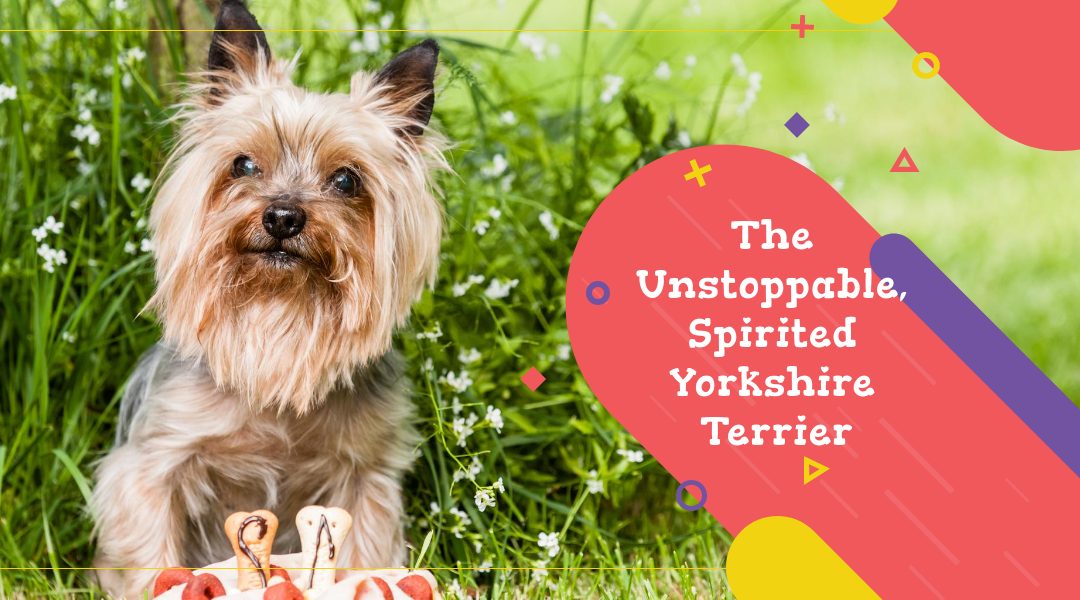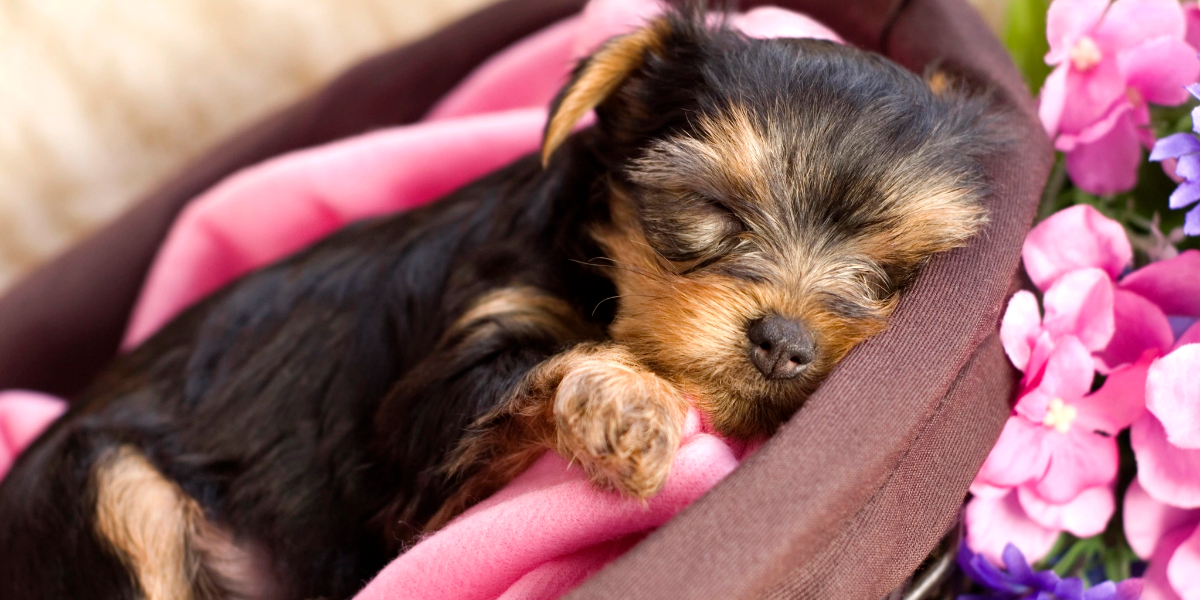A petite little fur ball. What an unassuming little dog. Unassuming? That could not be farther from the truth! In fact, the Yorkshire Terrier has so much character, you might wonder how one little dog could contain such a big personality without bursting at the seams!
We love the spirited Yorkshire Terrier!
History – Picture it… the mid-1800s in rugged Yorkshire, Northern England. Textile mills and coal mining ran much of the economy. But it became increasingly difficult to work with rats and mice and all kinds of scurrying varmint swarming all over the machinery and underfoot. The cotton and wool mills, in particular, were under siege from their gnawing little teeth making holes in profits. So, a group of industrious and determined workers gathered several varieties of Terriers together (Paisley, Clydesdale, Manchester, and Maltese, to name a few) with the goal in mind of making one fierce, spirited, obedient, stout and smart dog to rid them of their rodent problem. The result: the Yorkshire Terrier.
This brave, diminutive dog would not only chase the rats into the darkest of hiding spaces, but could easily and quickly learn commands. As an added bonus, they were happy, curious, and loyal companions. Their popularity grew throughout the countryside and Europe. Eventually in 1872, they were brought to America, and in 1885, were initiated into the AKC.
Yorkie Breed Standards
Over the years, through selective breeding of the smallest Yorkies, their size has diminished from what it was initially in the mid-1800s. Now, the average height is 6 – 7 inches, and average weight is 7 pounds (though some can be significantly smaller); the perfect size for smaller spaces and apartment living. The coat is mainly tan and steel gray, but there is a wide range of shade variations and combinations of the two.
Puppies can be brown, black, tan, and blonde, but will eventually develop the tan/gray combo as they grow up. The four main categories of adult coloring are: Black and Gold, Black and Tan, Blue (gray) and Tan, and Blue (gray) and Gold. The breed standard also calls for a docked tail, and many pups are docked to follow suit. The Yorkshire Terrier also has a flat head, erect V-shaped ears, and round, inquisitive eyes.
Never-ending Yorkie Energy
This little firecracker of a dog needs a daily dose of exercise or play. While they do love a good walk, you will need to keep them on a leash; their boldness far exceeds their size, and on occasion, they might initiate play with a much larger dog without your approval. If they go too long without enough exercise, you’ll know it! The Yorkie is prone to bursts of energy, tearing around the house. A healthy walk or run in an enclosed yard should do the trick though. Also, daily exercise is important in order to avoid “Small Dog Syndrome,” and other behavioral problems.
Small Dog Syndrome manifests in your pint-sized pooch trying to basically take charge of your household… and of you. Other behavior issues can be seen in increased barking, nipping, and separation anxiety, among other things. So be sure to spend some quality time with your little one working up a good pant! (Note: these dogs are excellent at agility and sporting events, so you might look to add them to a fly-ball or some other relay-type group activity. That would definitely provide the exercise they love so much).
Recognition – Of course the Yorkshire Terrier breed is recognised worldwide by breed associations such as The American Kennel Club.
Spirited Yorkshire Terrier Temperament
Here’s where the Yorkshire Terrier really shows its stuff! If ever there was a small dog that didn’t realize it was a small dog, it’s this one. Even Yorkie owners sometimes have difficulty explaining the various quirks and hijinks of their little pooches. They get along well with other dogs and children, though they don’t have a liking for the haphazard movements of some small children, which can startle them. The love to have company, but they can also have an independent streak.
These dogs definitely need an assertive pack leader as an owner, or they can become a bit bossy and yappy, but they are fast and eager learners, so the sooner they are trained, the better! It might be tempting to pamper this little beauty, but that’s usually the start of behavior issues. If trained though, the Yorkshire Terrier is a fantastic family dog, brave, loyal, and a jovial companion. Your Yorkshire Terrier breeder, Veterinarian, or local pet store can give you training tips and resources, as well as clue you in to training classes available in the area.
Yorkshire Terrier Health
The good news is that a healthy Yorkshire Terrier can live 15-18 years. The bad news is that if the Yorkie is less than healthy, there are quite a few health problems that can develop. On the broad scale, Yorkies can suffer from lung problems (such as bronchitis), lymphangiectasia (the dilation of lymph vessels in the intestines), liver shunts, herniated disks, cataracts, dry eye syndrome, tooth decay, and digestive problems. They are also usually very sensitive to anesthesia, so any procedures will need to be carefully monitored or avoided altogether. Since they are such small dogs, their spines, joints, and bones can easily be injured in falls or overly-rough handling. Avoid exotic treats and food, as it will most definitely not agree with them.
But, by far, the most common problem with Yorkies is dental decay. Their mouths are so small that their teeth can become crowded and not fall out from puppyhood to adulthood as with other dogs. Cleaning can also be difficult, and bacteria and plaque can build up quickly. Unfortunately, this bacteria can spread to other organs, like the heart and kidneys, leading to other, much more serious health problems.
Grooming Yorkshire Terrier
Here too, we find both good news and bad news for the Yorkshire Terrier. The good news is that if you have no intention to show your Yorkie, your grooming needs are cut in half. Brushing every other day, washing twice a month, and a trip to the groomer once every 4-6 weeks for a puppy cut should take care of most of it. True, the shorter cut might leave your pup looking a bit shaggy and scruffy, but it will be much easier on the wallet, that’s for sure. If you feel comfortable doing it, you might need to clip the hair over the eyes in between groomer visits. If you’d rather not be trusted to clip the hair, tying it back in a top knot would do. Hair in the eyes can lead to tearing, staining, and more serious eye irritations.
Negatives – That’s a whole lotta personality in that pint-sized pooch, and if you are not willing to guide with a firm but gentle hand, you just might find yourself on the receiving end of a bossy barking dog. The Yorkshire Terrier also can develop health, tooth, and digestive problems if not handled with care. And that coat is going to require some semi-frequent grooming, so be prepared to brush daily (try to turn it into a positive, playtime experience) and visit the groomers every month or so.
Positives – Yorkies are confident, bold, inquisitive, loving, and loyal. Their compact size often cannot contain all that they have to offer their owners in terms of love and happiness. Exceedingly sweet and exceptional watchdogs, if you’re looking for a pee-wee package of jumbo personality, this is the dog for you!
From a very modest and meager beginning as a true working-class dog, to the Best in Show ring and the laps of doting owners today, the Yorkshire Terrier has run the gamut and managed to find a permanent position in the hearts of dog lovers the world over.







The Yorkshire Terrier that we have now is our SECOND one.
“Bailey” is now 4 years old, and he is a powerhouse of energy and fun. This little guy is everything we expected , and more. The only thing that we seem to have an issue with is his tendency to shy away from us when we attempt to pick him up. He will come when you call him, but as either my wife or myself reaches out for him, he backs up, just out of reach. He is also a “bolter” ! If he gets within sight of a door, he will run, and he comes back home when he is ready! He has been this way since we got him from the breeder.
That backing away is so Yorkie!! We’ve had 3 and they all do the same thing!! My older one would come and stand for me once I took command and used that Dog Whisperer energy. It took a bit of patience but once she figured out she wasn’t getting what was at the end of the battle till she surrendered it was so easy! She was also a bolter but we found that we had to wait till the excitement leveled out before the door opened – there was no holding her back and they are are so stinking fast!!! Our second shot at raising a Yorkie now includes 2! I am learning all I can from training info and comparing what I learn with how I handled our first baby and have already had so much more success with these guys👍🏻👍🏻 They don’t get the “come” treat till they are in my hands! Be calm and assertive and use lots of treats!!! You have to be more fun than what they are fixated on🤪